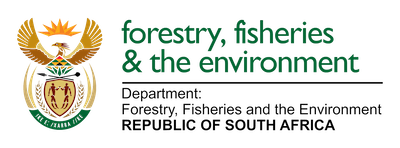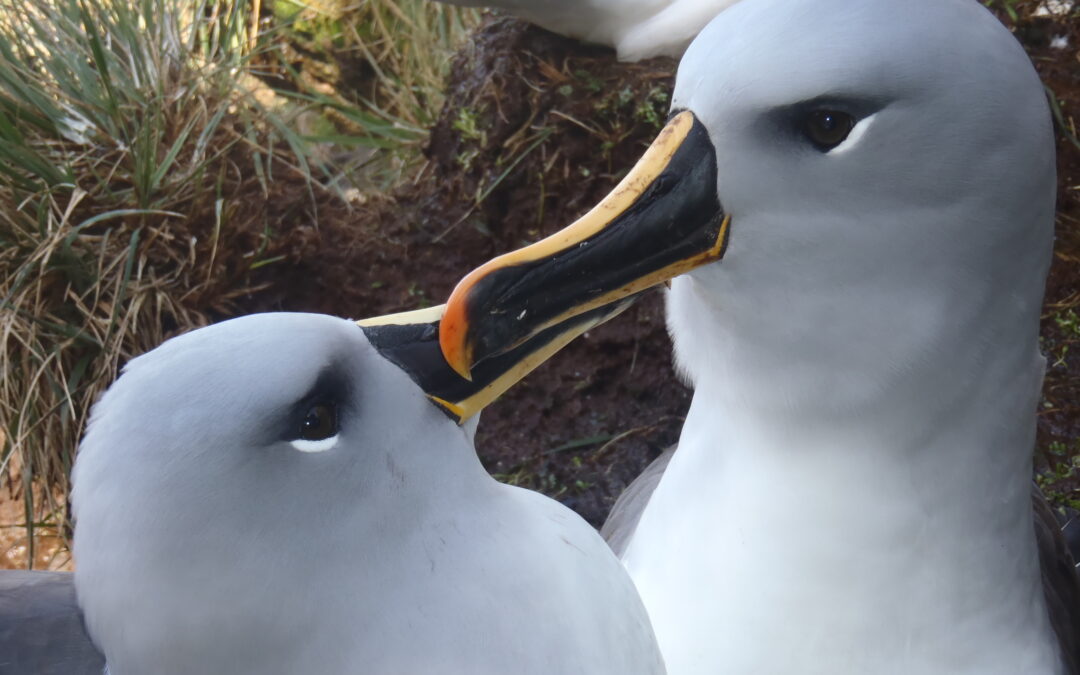
by Ria Olivier | Jun 19, 2022 | Announcement, Environment, Important Dates, International Days, Marion Island, Prince Edward Islands, Southern Ocean, sub-Antarctic
World Albatross Day was inaugurated by the Agreement on the Conservation of Albatrosses and Petrels (ACAP) in 2020 and is now celebrated annually on 19 June.
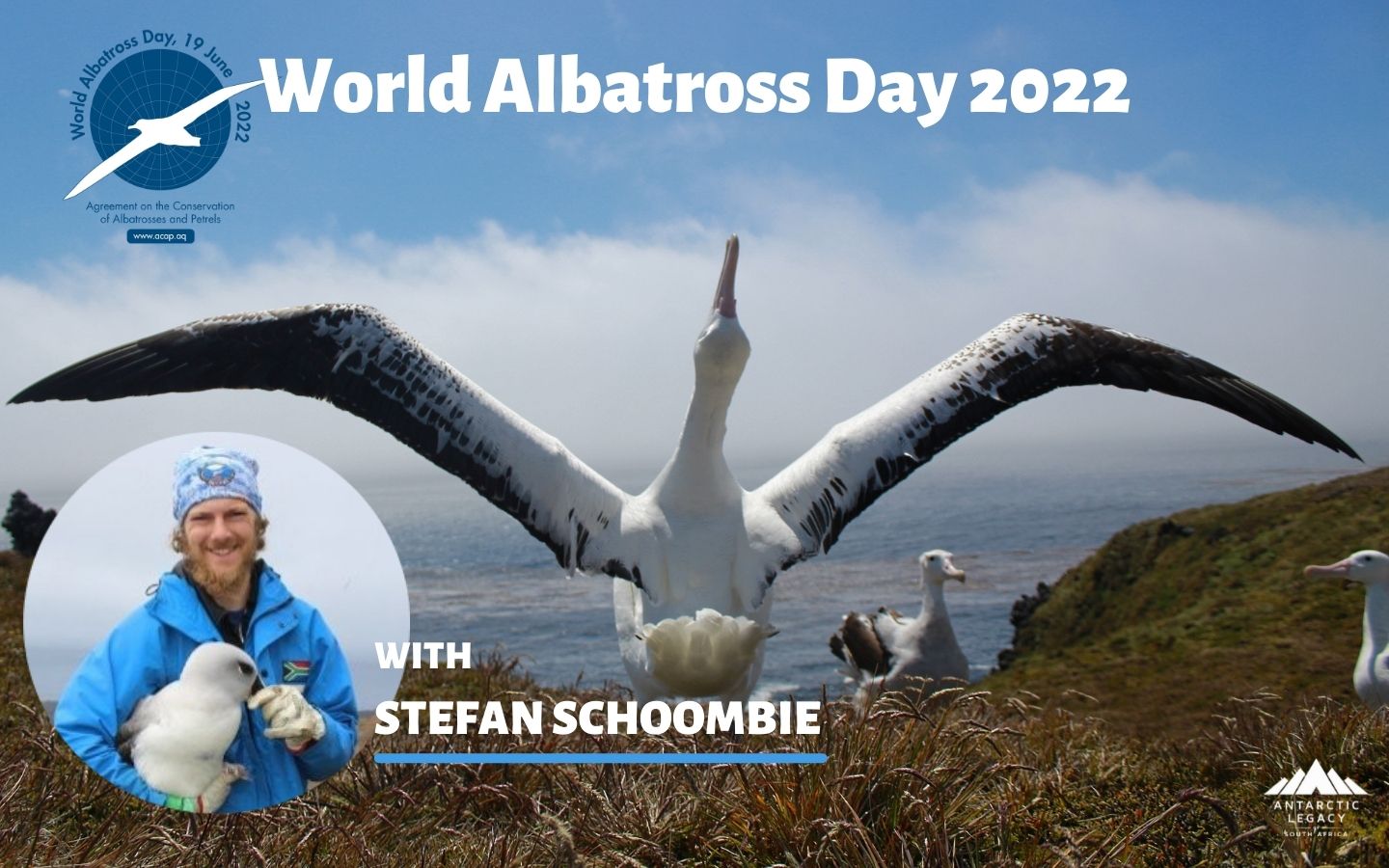
I have spent the past eight years in close contact with albatrosses, but have realised that many don’t really know of their existence and/or importance. World Albatross Day is a very important initiative to highlight the wonders of these special birds, as well as the threats they face on a daily basis.
Stefan Schoombie, a PhD in Biological Sciences at the University of Cape Town. His research focus is on the behaviour of seabird species.
How did you end up working on seabirds in the sub-Antarctic?
After finishing a BSc (Hons) at the University of KwaZulu-Natal in 2012, I had the opportunity to overwinter on Marion Island as part of the 70th overwintering expedition. During this expedition (2013-2014) I worked as a field assistant (for Fitzpatrick Institute of African Ornithology), monitoring seabird colonies, and gathering data for my Master’s degree.
I was fortunate enough to join several more expeditions to Marion Island between 2015 and 2019, this time gathering data towards my PhD degree, while performing other research activities with the ultimate goal of seabird conservation.
Read more about Stefan’s research and publications here!
How would you describe your first encounter with an albatross?
The first albatross I encountered was a Wandering Albatross, sitting on a nest on Marion Island. The sheer size of the bird was unbelievable, but the fact that they are so calm in our presence was incredible. Adult albatrosses breeding on sub-Antarctic Islands have no natural predators while on land, and thus they are not as scared of us as most land birds that we are used to. However, the most amazing thing about a Wandering Albatross is when they open their wings and reveal a three-meter wingspan.
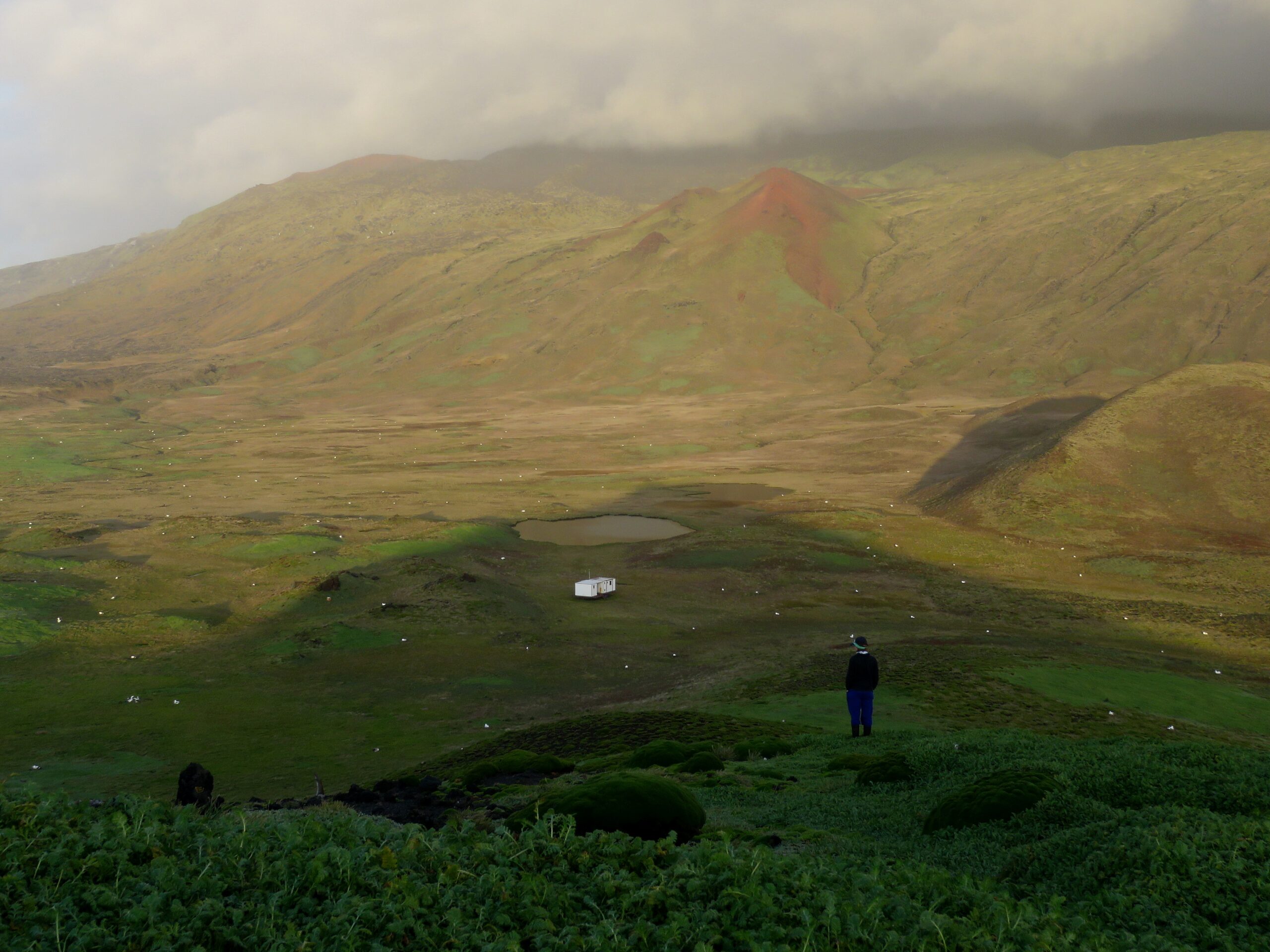
Swartkops hut (on the Western side of Marion Island) and hundreds of Wandering Albatross nests.
The different Albatross species on Marion Island are each unique in their own way. How would you describe the uniqueness of each species?
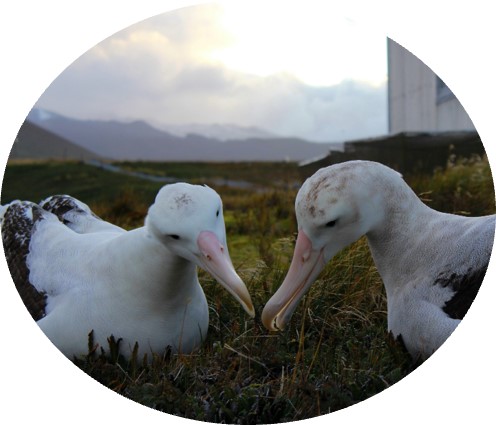 WANDERING ALBATROSS
WANDERING ALBATROSS
By far the most impressive of the albatrosses when you are up close. I tracked the fine-scale movements of these birds for my PhD degree, resulting in a lot of close encounters with them. We also monitored hundreds of breeding birds, as part of a long-term monitoring program. I was fortunate enough to spend enough time on Marion Island to see albatross chicks grow up from tiny chicks up to the point where they were large and strong enough to fly off into the vast Southern Ocean skies. Part of my research included the use of bird-borne cameras, where we were able to see what the birds experienced from their point of view, giving me a new-found respect for the incredible flying capabilities of these birds.
 SOOTY (OR DARK-MANTLED SOOTY) ALBATROSS
SOOTY (OR DARK-MANTLED SOOTY) ALBATROSS
These were the first albatross species I worked with, while gathering data for my MSc. Part of my research included setting up a long-term monitoring colony of Sooty Albatrosses. This included marking a large number of birds with unique numbered rings, for identification, which is particularly challenging seeing that these are cliff-nesting birds. One of the most memorable things about Sooty Albatrosses is their calls, which echo along the cliffs as they call to their partners. They also perform a synchronised flight as part of their courtship which is something to behold.
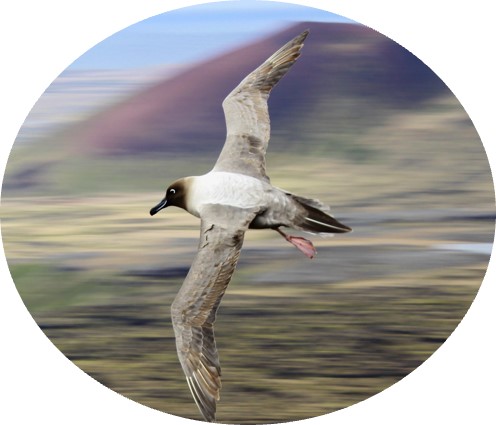 LIGHT-MANTLED (OR LIGHT-MANTLED SOOTY) ALBATROSS
LIGHT-MANTLED (OR LIGHT-MANTLED SOOTY) ALBATROSS
These birds are very similar to the Sooty Albatross and I conducted the same research as with the Sooty Albatrosses. Light-mantled Albatrosses are more common in the southern parts of the Southern Ocean, with Marion Island being their northernmost breeding ground. Thus, their population size is quite small on Marion and the birds are a bit more skittish than other species.
 GREY-HEADED ALBATROSS
GREY-HEADED ALBATROSS
These are incredibly beautiful birds that are very photogenic, but their cliff-nesting behaviour makes them difficult to get close to. Apart from a small monitoring colony, we normally don’t come close to these birds and only perform annual counts with binoculars. However, in 2015 increases in attacks from invasive house mice resulted in us monitoring them much closer. Grey-headed Albatrosses breed in dense colonies which is like a very noisy, busy airport terminal, with birds landing and taking off all around you.
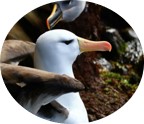
BLACK-BROWED ALBATROSS
Marion Island is not a breeding ground for Black-browed Albatrosses, but there is one vagrant individual that breeds with Grey-headed Albatrosses from time to time, resulting in hybrid offspring.
Seabirds of the sub-Antarctic are under threat due to unsustainable fishing practices, climate change, and invasive species. Currently, on Marion Island, the invasive house mice are threatening the albatross species living and breeding on this sub-Antarctic island. The Mouse-Free Marion Project (partnering with BirdLife South Africa and the South African Department of Forestry, Fisheries and the Environment) aims to remove the mice from Marion Island in 2024.
YOU CAN HELP SAVE MARION ISLAND’S SEABIRDS
View the ACAP Media Release for this Year’s Albatross Day
Anche Louw, Antarctic Legacy of South Africa, 19 June 2022.
Images: Stefan Schoombie.
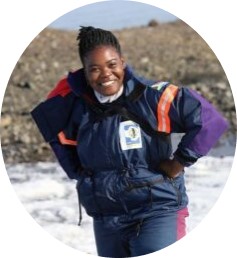
by Ria Olivier | Jun 16, 2022 | Announcement, Antarctica, Environment, Gateway cities, Important Dates, News, Women in Science
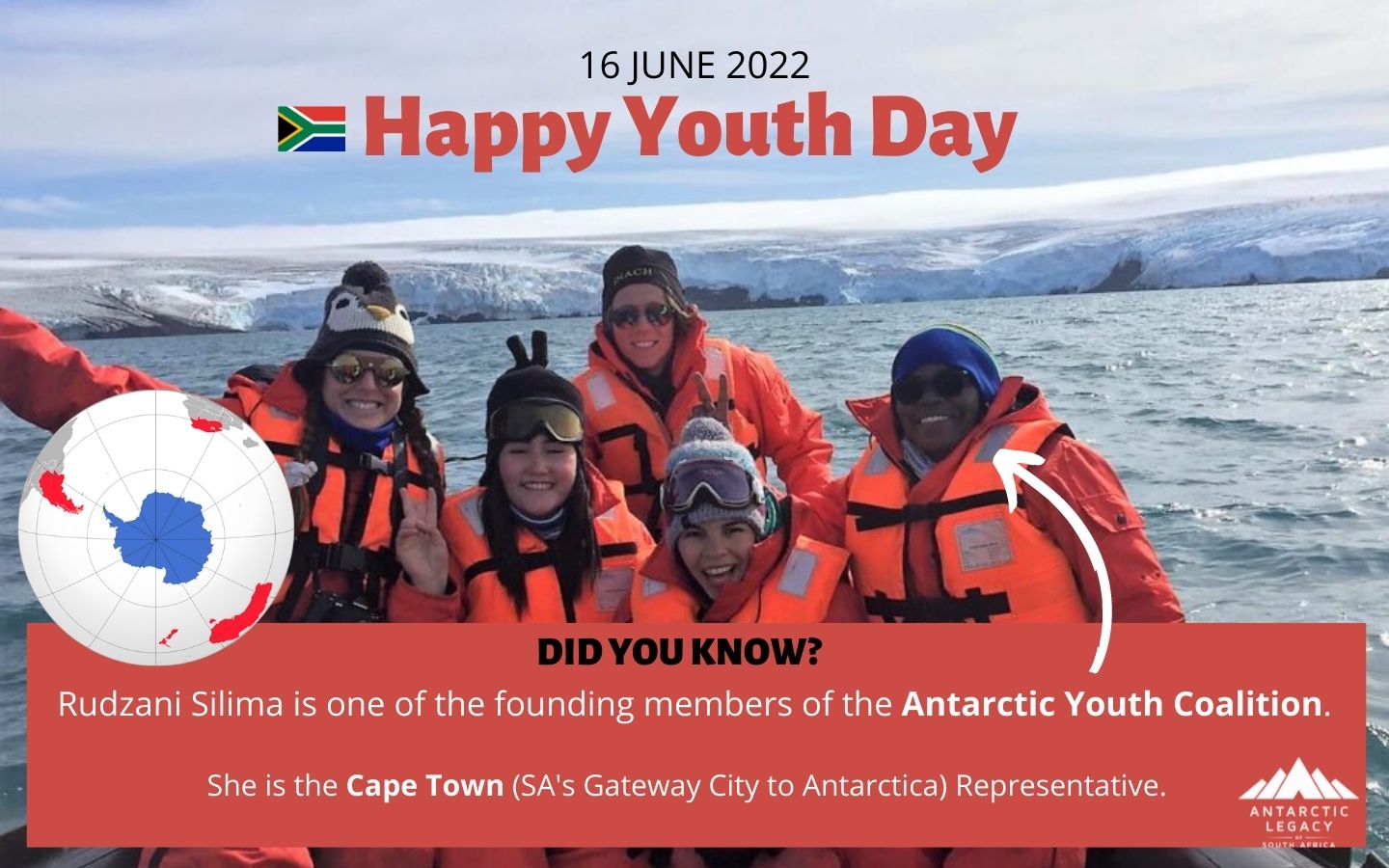
Youth Day 2022 Theme: Promoting sustainable livelihoods and resilience of young people for a better tomorrow.
The call to action will be for youth to forge resilience and pursue opportunities for a sustainable livelihood, today and in the future (South African Government).

Rudzani Silima, a South African National Antarctic Programme (SANAP) graduate, is one of the founding members of the Antarctic Youth Coalition. She is a custodian for South Africa’s gateway city to Antarctica (Cape Town) and “advocating for Antarctica’s future, by promoting sustainable communities and connected urban identities” (AYC).
The five gateway cities to Antarctica:
- Cape Town (South Africa)
- Hobart (Australia)
- Christchurch (New Zealand)
- Punta Arenas (Chile)
- Ushuaia (Argentina)
Who is the Antarctic Youth Coalition?
How did Rudzani become one of the founding members?
Want to know more about Rudzi? Click here!
The Antarctic Youth Coalition is an initiative of the Project: Antarctic cities and the global commons: Rethinking the Gateways.
Read more about the Antarctic Cities Project
Anche Louw, Antarctic Legacy of South Africa, 16 June 2022.
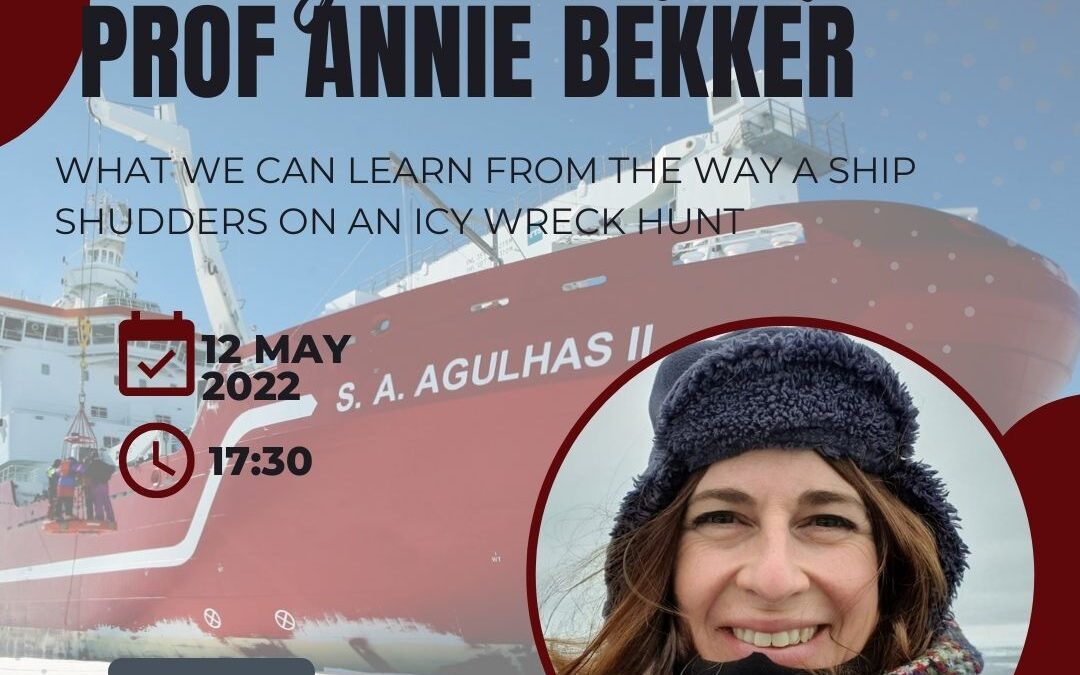
by Ria Olivier | May 11, 2022 | Announcement, Antarctica, Engineering, Environment, News, Research, SA Agulhas II, SANAP, Southern Ocean
Her lecture title is: What can we learn from the way a ship shudders on an icy wreck hunt.
For more info and a link to the LIVE event, click
here.
S.A. Agulhas II Image Credit: Ken Findlay.
Anche Louw, Antarctic Legacy of South Africa, 11 May 2022
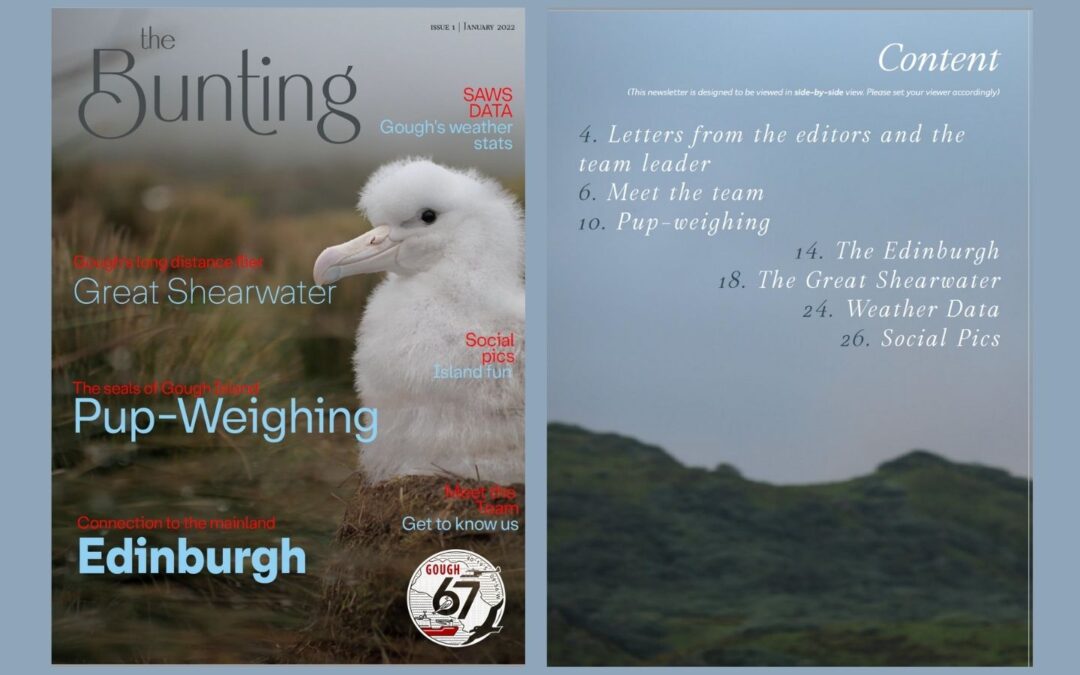
by Ria Olivier | Feb 2, 2022 | Announcement, Environment, Gough Island, News, Newsletters>Gough Island Newsletters, Overwintering Team, Team member
In this edition:
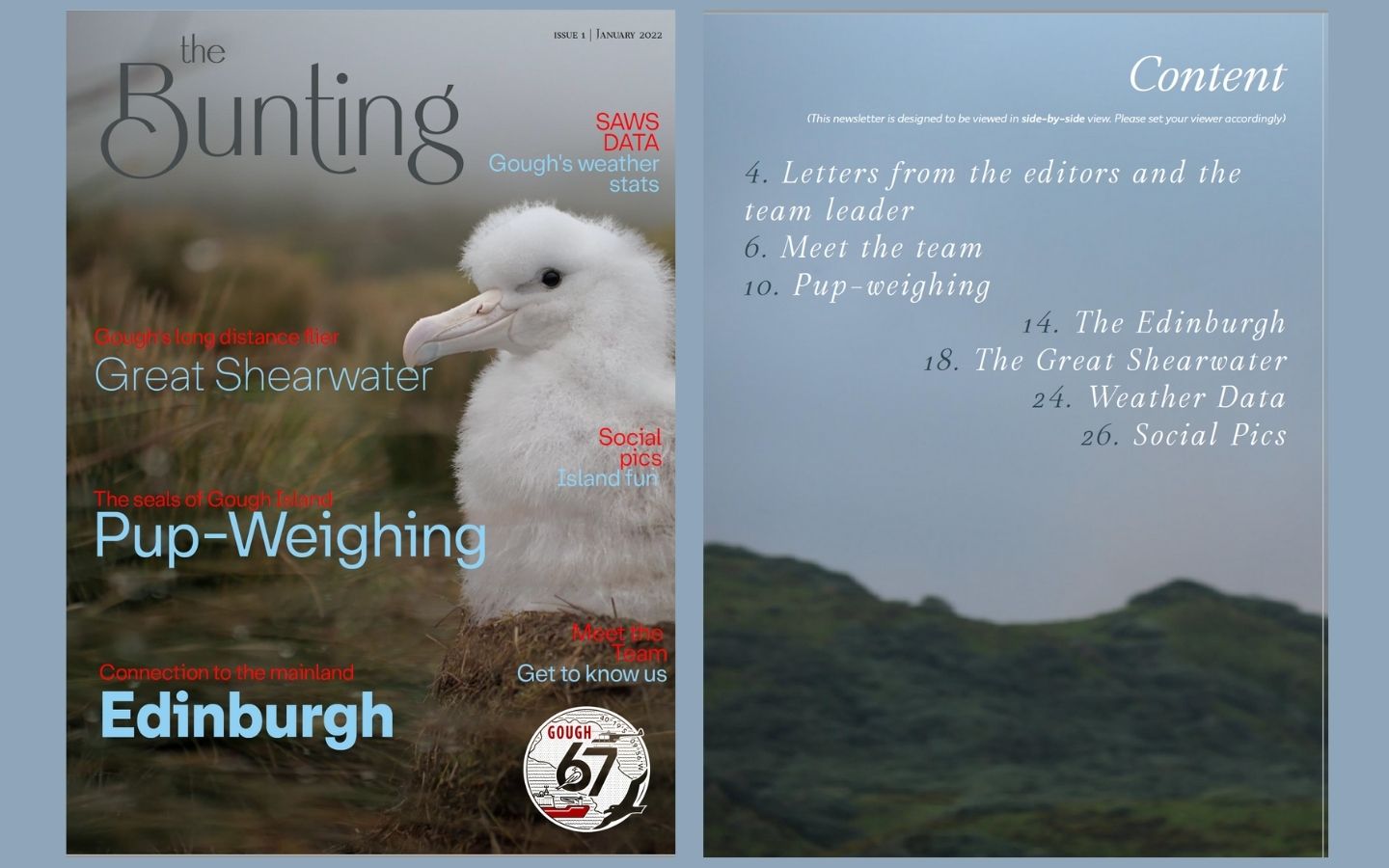
- Meet the 67th Gough Island Overwintering Team
- Prof Marthan Bester writes about Fur Seal pup weighing at Tristan da Cunha Islands (2009 – 2021)
- Read more about the Edinburgh ship – connecting Gough with the mainland
- More about the million breeding pairs of Great Shearwater birds on Gough Island
- Weather data of October, November, and December 2021
- Check out some great social gathering pictures!!
Click here to download this issue!!
Click here to view all The Gough Bunting (Gough Newsletters) available on the ALSA Archive.
Anche Louw, Antarctic Legacy of South Africa, 02 February 2022
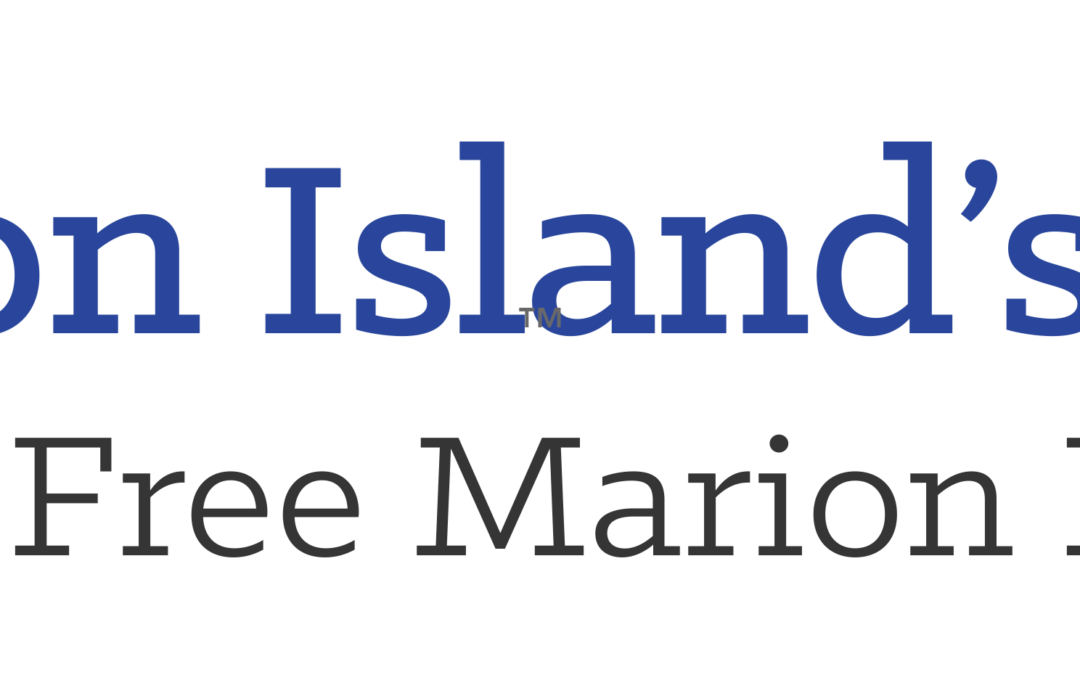
by Ria Olivier | Aug 27, 2021 | Environment, Marine Protected Area, Marion Island, Mice Eradication, Research, SANAP, Science
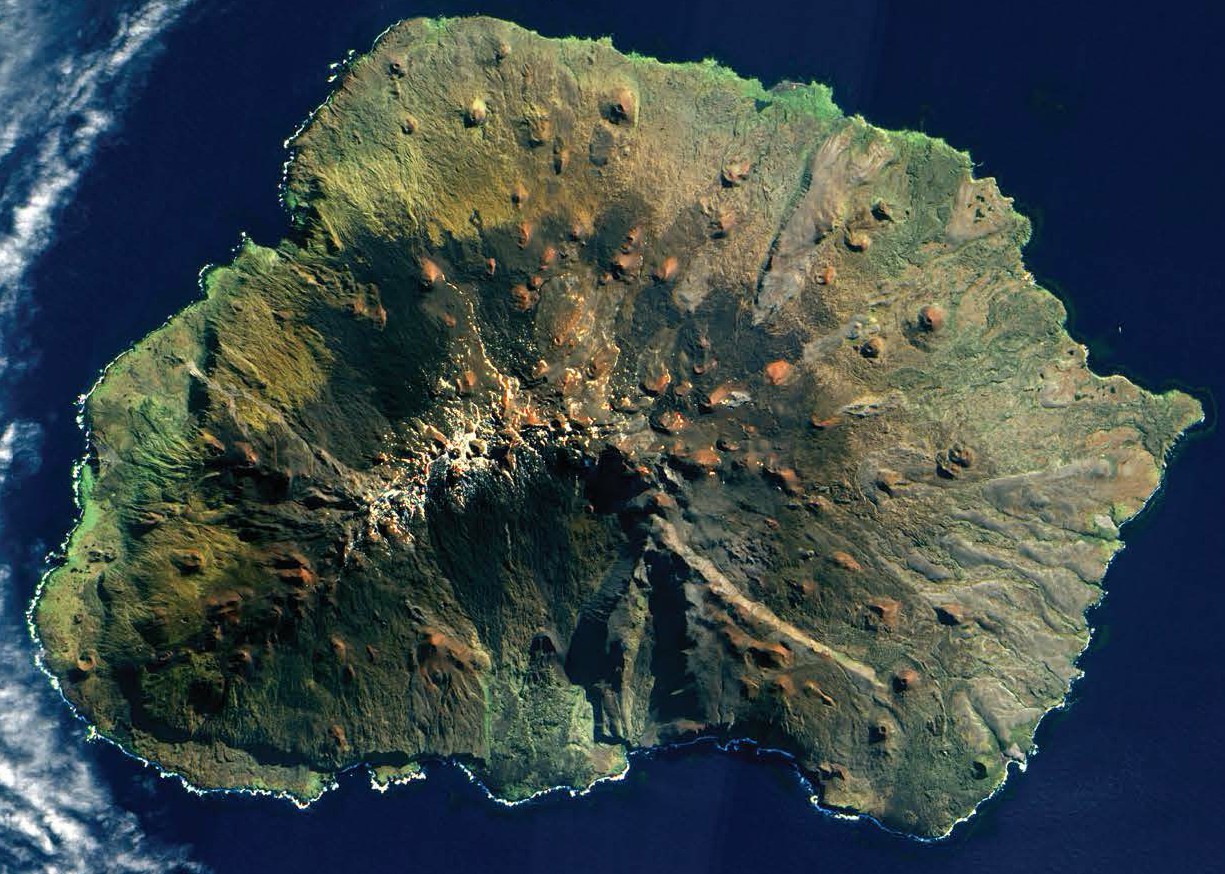
Ecosystem processes are changing worldwide, especially with the impacts of invasive species being exacerbated by climate change. 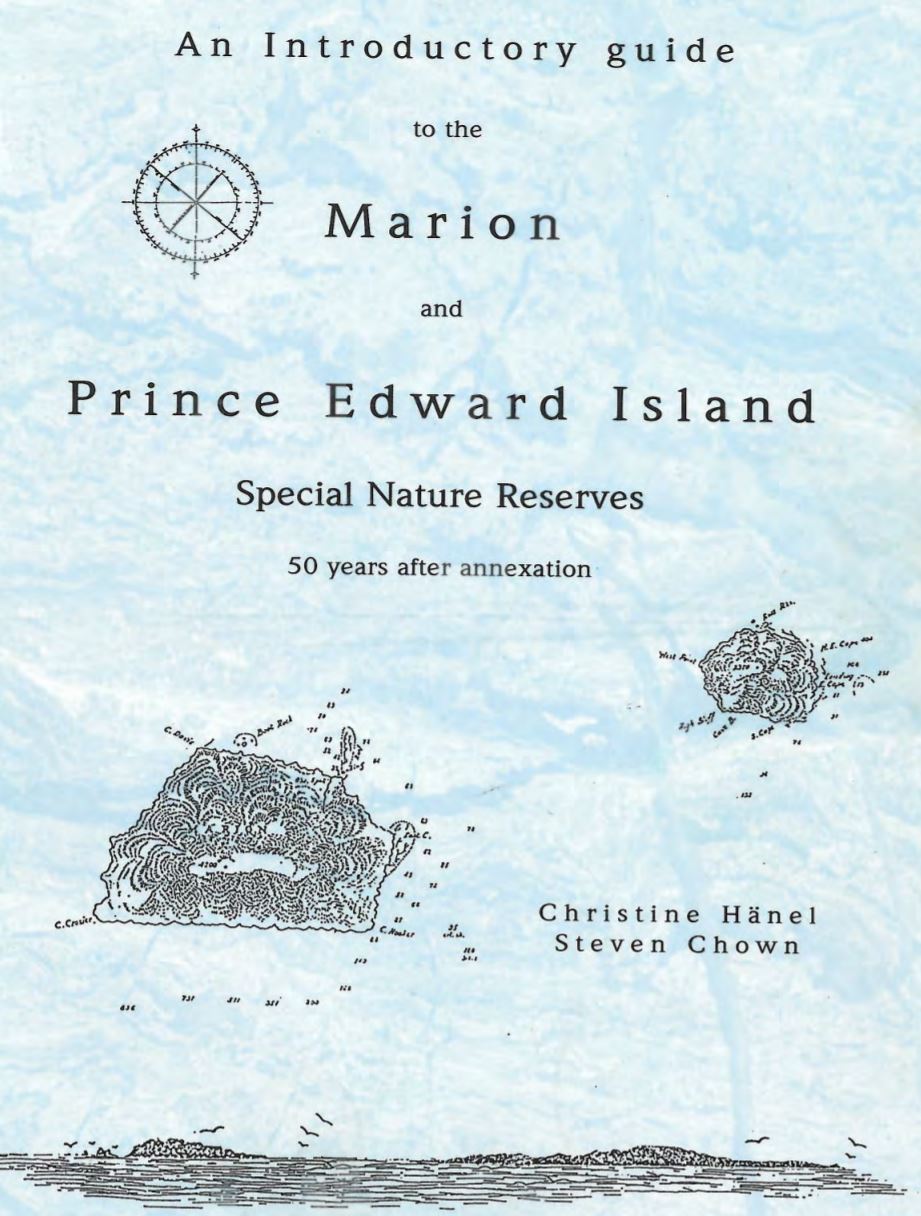 This is particularly obvious in the Southern Ocean where a warmer and dryer environment allows the proliferation of species once limited by the cold climate. South African Special Nature Reserve, Marion Island is no exception. A recent proliferation of invasive House Mouse attacks on endangered breeding seabirds suggests a profound alteration of the natural ecosystem. This has led to the planned eradication of mice at Marion Island in winter 2023.
This is particularly obvious in the Southern Ocean where a warmer and dryer environment allows the proliferation of species once limited by the cold climate. South African Special Nature Reserve, Marion Island is no exception. A recent proliferation of invasive House Mouse attacks on endangered breeding seabirds suggests a profound alteration of the natural ecosystem. This has led to the planned eradication of mice at Marion Island in winter 2023.
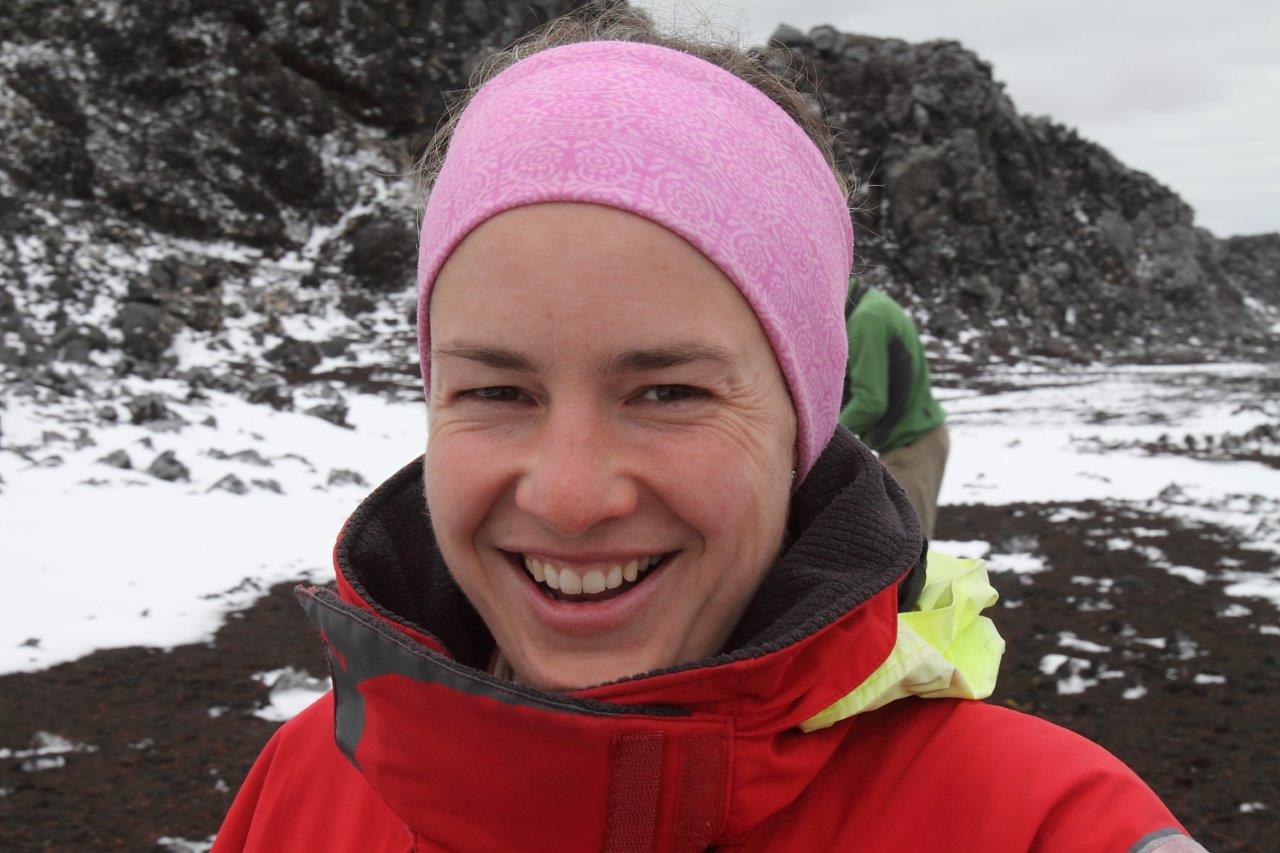
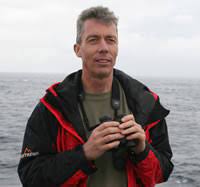 For the next three years, the new SANAP project co-led by Dr Maëlle Connan (Research Fellow in the Marine Apex Predator Research Unit, Nelson Mandela University) and Prof. Peter Ryan (director of the FitzPatrick Institute of African Ornithology – University of Cape Town) will focus on three data deficient species of avian scavengers: Black-faced Sheathbill, Kelp Gull and Brown Skua.
For the next three years, the new SANAP project co-led by Dr Maëlle Connan (Research Fellow in the Marine Apex Predator Research Unit, Nelson Mandela University) and Prof. Peter Ryan (director of the FitzPatrick Institute of African Ornithology – University of Cape Town) will focus on three data deficient species of avian scavengers: Black-faced Sheathbill, Kelp Gull and Brown Skua.
By focusing on these three species and some of their prey, the project intends first to fill identified scientific gaps that are crucial for best planning of the mouse eradication. Second, these three scavengers will be used as indicators of recovery of the terrestrial ecosystem post-eradication by establishing baselines for the scavenger guild and their prey against which the impact of a successful mouse eradication can be measured in years to come. (Above: Left – Maelle Connan, Right – Peter Ryan)
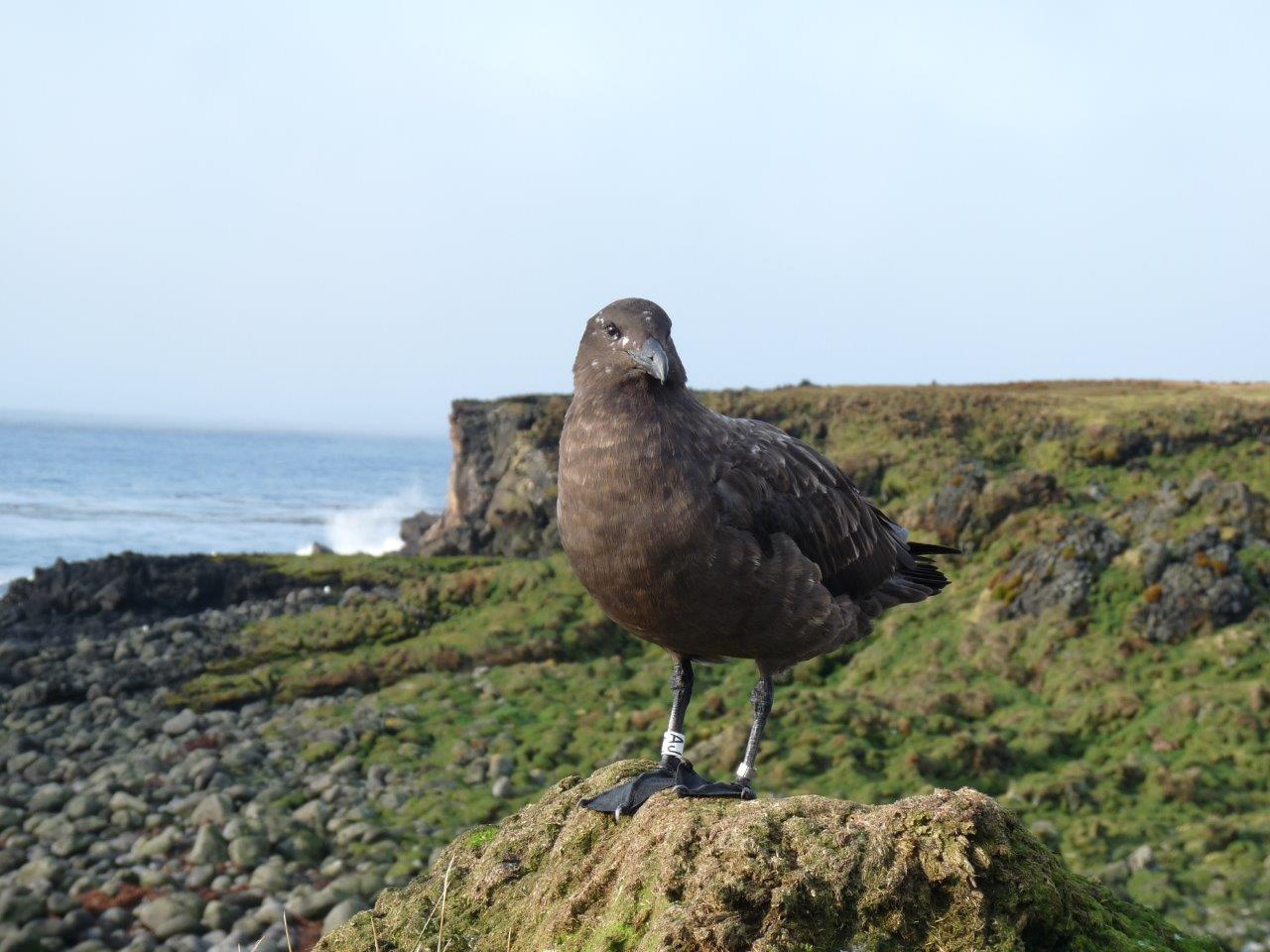
 (Above l-r: Sub-Antarctic Skua, Black-Faced Sheathbill)
(Above l-r: Sub-Antarctic Skua, Black-Faced Sheathbill)

(Above: Eleanor Weideman on Marion Island)
An important aspect of the project will entail conducting regular censuses and seasonal round island counts in addition to behavioural observations of the focal scavenger species. Indeed, the three species to be studied are at the top of the terrestrial food chain, and thus can be used as indicators of recovery of the island biota post-eradication.
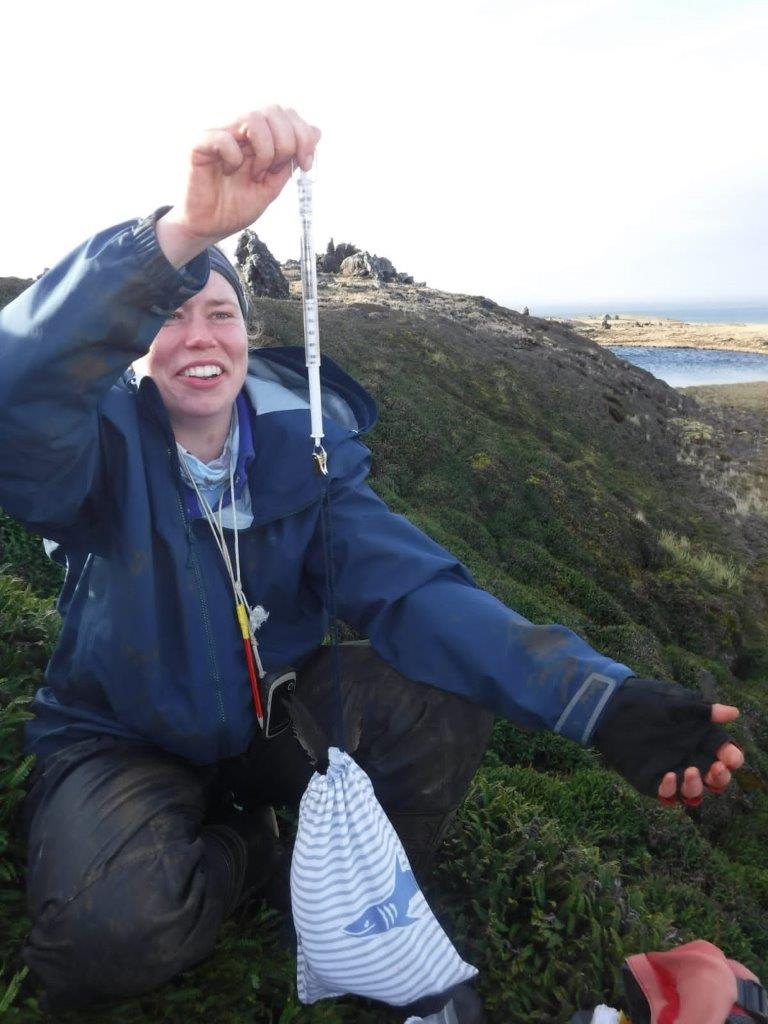 On one hand, Black-faced Sheathbills and Kelp Gulls used to predate on terrestrial invertebrates, at least seasonally, but this behaviour has decreased in sheathbills as invertebrate populations have collapsed through mouse predation. There are no recent data for Kelp Gulls. On the other hand, many pairs of Brown Skuas predate mainly on burrowing petrels, thus will inform on the recovery of these nocturnal species from mouse predation. The skua data will be complemented by the implementation of an automated acoustic monitoring to detect the presence and coarse distribution of the most elusive and cryptic nocturnal species which are notoriously difficult to study. (Left – Eleanor Weideman in the field on Marion Island.)
On one hand, Black-faced Sheathbills and Kelp Gulls used to predate on terrestrial invertebrates, at least seasonally, but this behaviour has decreased in sheathbills as invertebrate populations have collapsed through mouse predation. There are no recent data for Kelp Gulls. On the other hand, many pairs of Brown Skuas predate mainly on burrowing petrels, thus will inform on the recovery of these nocturnal species from mouse predation. The skua data will be complemented by the implementation of an automated acoustic monitoring to detect the presence and coarse distribution of the most elusive and cryptic nocturnal species which are notoriously difficult to study. (Left – Eleanor Weideman in the field on Marion Island.)
Data obtained during the project will be swiftly shared to the Mouse-Free Marion programme manager Dr Anton Wolfaardt, to ensure updated information is available for the best planning of the mouse eradication.
 Cover Image: Sub-Antarctic Skua – photo credit: Maelle Connan
Cover Image: Sub-Antarctic Skua – photo credit: Maelle Connan
Text supplied by Maelle Connan.
Photo Credits: Maelle Connan, Yinhla Shihlomuhe, Isabel Micklem.
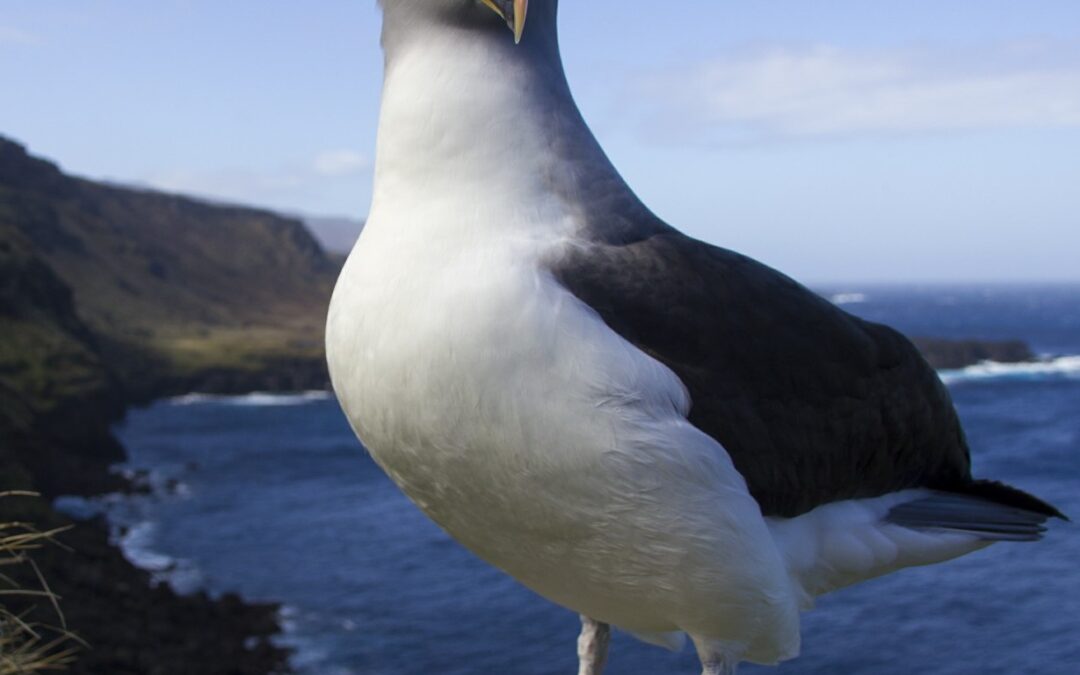
by Ria Olivier | Jul 5, 2021 | Biosecurity, Environment, Invasion Biology, Marion Island, Mice Eradication, Research, Science
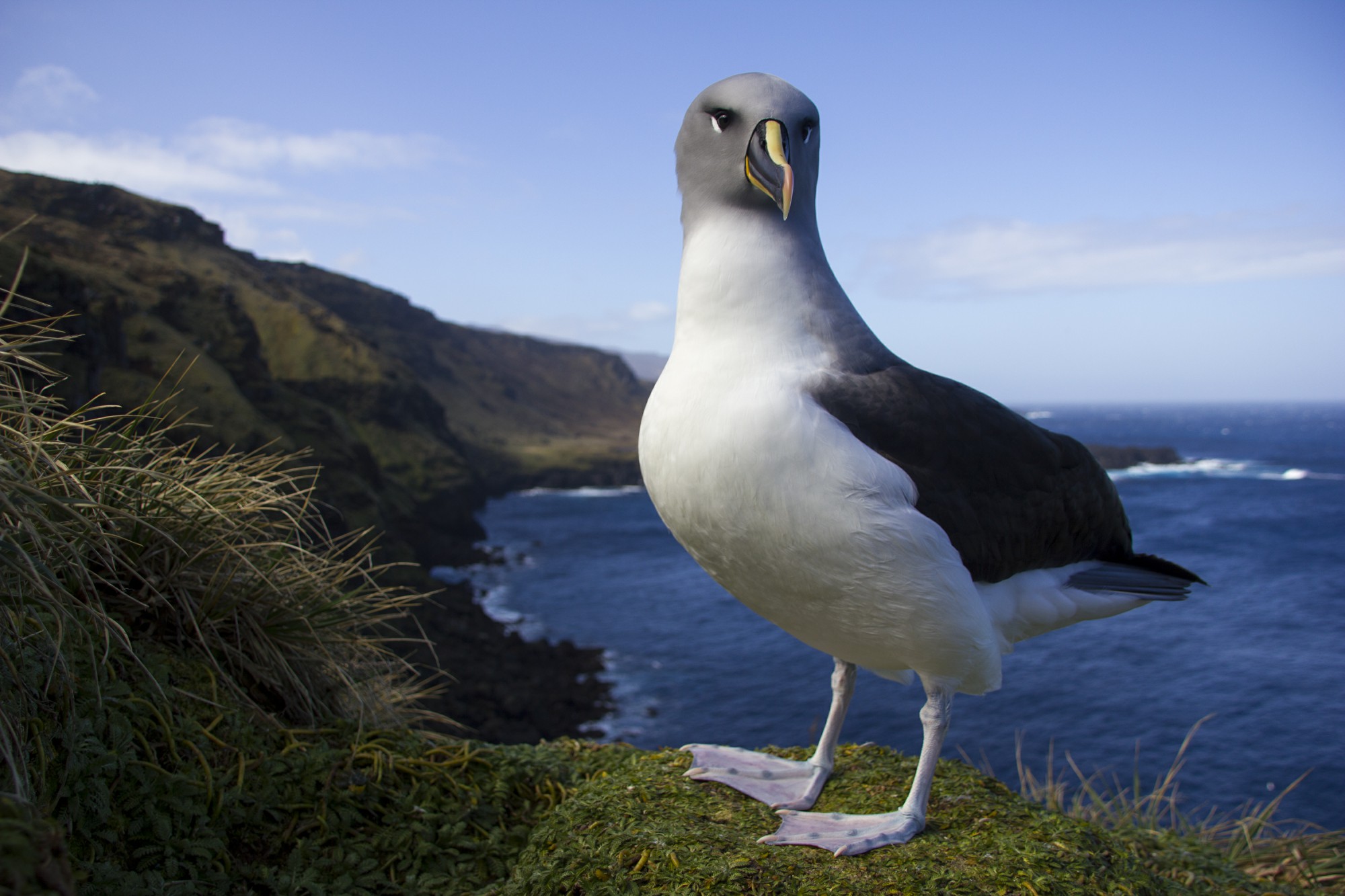

 Marion Island (29 000 hectares) and Prince Edward (4500 hectares), collectively known as the Prince Edward Islands (PEIs) were annexed by South Africa in December 1947 and January 1948, respectively. Since then, South Africa has maintained a research and weather station on Marion Island, Prince Edward remains uninhabited. The PEIs were declared a Special Nature Reserve in 1995, a Ramsar Wetland Site of International Importance in 2007 and the surrounding waters a Marine Protected Area in 2009. The islands, governed by a suite of national environmental legislation under the Prince Edward Islands Management Plan (which includes a plan for the control and eradication of invasive alien species), are managed by the Oceans and Coasts Branch of the Department of Forestry, Fisheries and the Environment (DFFE) as the designated Management Authority under the National Environmental Management Protected Areas Act 57 of 2003.
Marion Island (29 000 hectares) and Prince Edward (4500 hectares), collectively known as the Prince Edward Islands (PEIs) were annexed by South Africa in December 1947 and January 1948, respectively. Since then, South Africa has maintained a research and weather station on Marion Island, Prince Edward remains uninhabited. The PEIs were declared a Special Nature Reserve in 1995, a Ramsar Wetland Site of International Importance in 2007 and the surrounding waters a Marine Protected Area in 2009. The islands, governed by a suite of national environmental legislation under the Prince Edward Islands Management Plan (which includes a plan for the control and eradication of invasive alien species), are managed by the Oceans and Coasts Branch of the Department of Forestry, Fisheries and the Environment (DFFE) as the designated Management Authority under the National Environmental Management Protected Areas Act 57 of 2003.

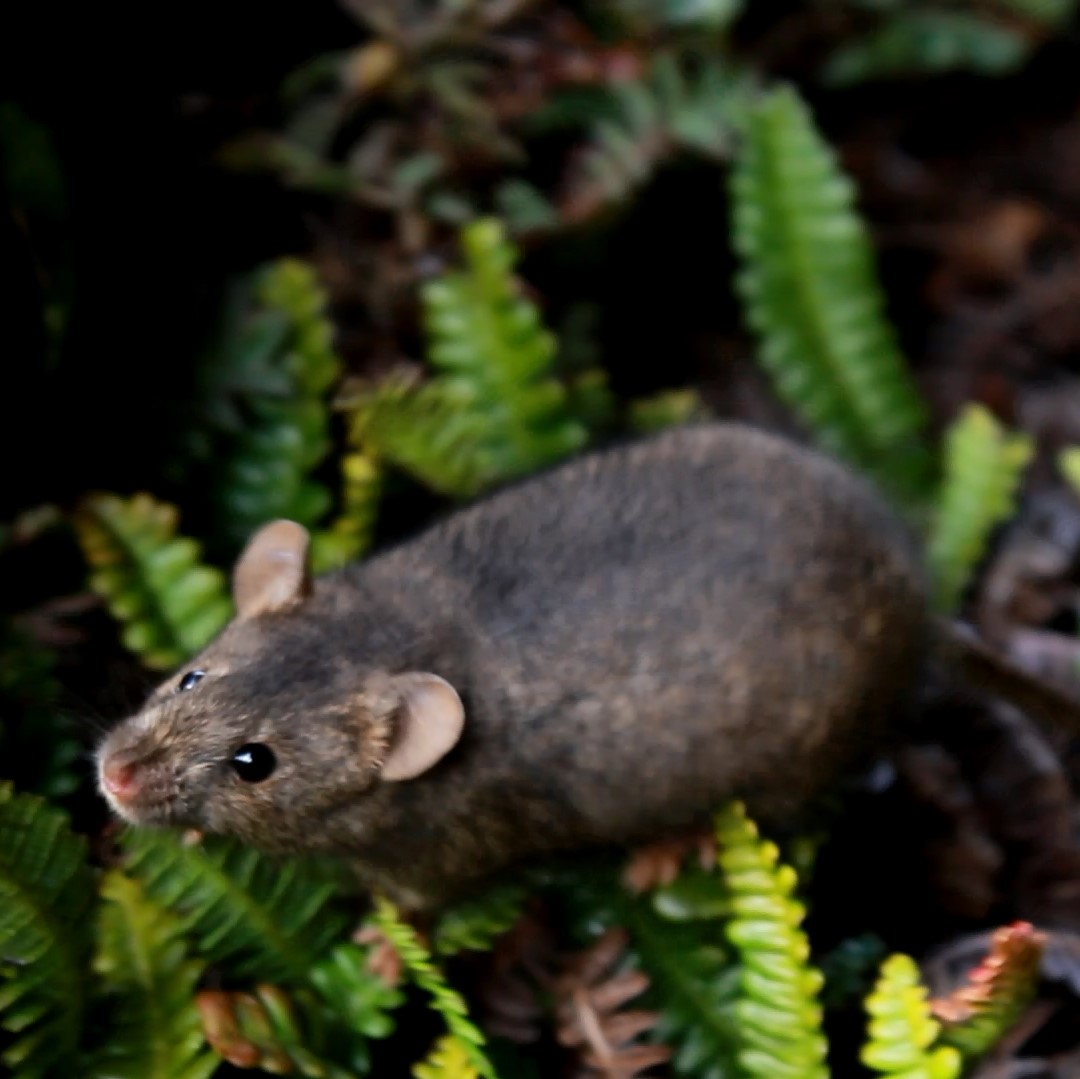
 The House Mouse Mus musculus (Photo Credit: Stefan Schoombie), inadvertently introduced to Marion Island by sealers in the early 1800s, successfully established on the island. With the human occupation of the island in 1948, four cats were brought to the island to control the mice in and around the station. However, these cats bred on the island, with their offspring becoming feral, and by the 1970s the population had increased to about 2000 individuals that were killing some 450 000 birds per year, mostly chicks of burrow-nesting species.
The House Mouse Mus musculus (Photo Credit: Stefan Schoombie), inadvertently introduced to Marion Island by sealers in the early 1800s, successfully established on the island. With the human occupation of the island in 1948, four cats were brought to the island to control the mice in and around the station. However, these cats bred on the island, with their offspring becoming feral, and by the 1970s the population had increased to about 2000 individuals that were killing some 450 000 birds per year, mostly chicks of burrow-nesting species.
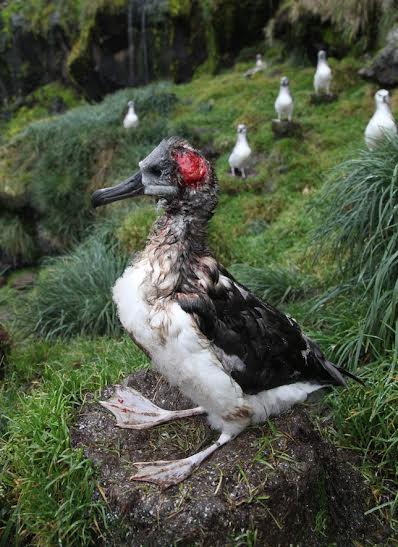 With South Africa’s successful eradication of the cats in 1991 (confirmed in 1992), until recently the largest island upon which this has been achieved, the mice continued to thrive and over the years have had devastating effects on Marion’s fragile ecosystem by negatively affecting invertebrate densities, impacting on the vegetation by consuming seed loads and preying upon the chicks of burrowing petrels (since the 1980s) and surface-breeding albatrosses (since 2003), with ‘scalpings’ occurring from 2009 and attacks on adult birds recorded more recently in 2019. (Image Credit: FitzPatrick Institute)
With South Africa’s successful eradication of the cats in 1991 (confirmed in 1992), until recently the largest island upon which this has been achieved, the mice continued to thrive and over the years have had devastating effects on Marion’s fragile ecosystem by negatively affecting invertebrate densities, impacting on the vegetation by consuming seed loads and preying upon the chicks of burrowing petrels (since the 1980s) and surface-breeding albatrosses (since 2003), with ‘scalpings’ occurring from 2009 and attacks on adult birds recorded more recently in 2019. (Image Credit: FitzPatrick Institute)
Marion Island supports some 25% of the world’s breeding population of Wandering Diomedea exulans, 12% of Sooty Phoebetria fusca and 7% of Grey-headed Thalassarche chrysostoma Albatrosses and smaller percentages of Light-mantled Albatrosses P. palpebrata and Grey Petrels Procellaria cinerea. It is clear something needs to be done or the severe impact of the mice could result in critical impacts on global populations and in the extirpation of up to 18 of the 27 bird species found on Marion within the next 30 to 100 years. (below l-r: Wandering Albatross, Sooty Albatross and chick, Grey-headed Albatross and chick. (Photo Credit: Stefan Schoombie)
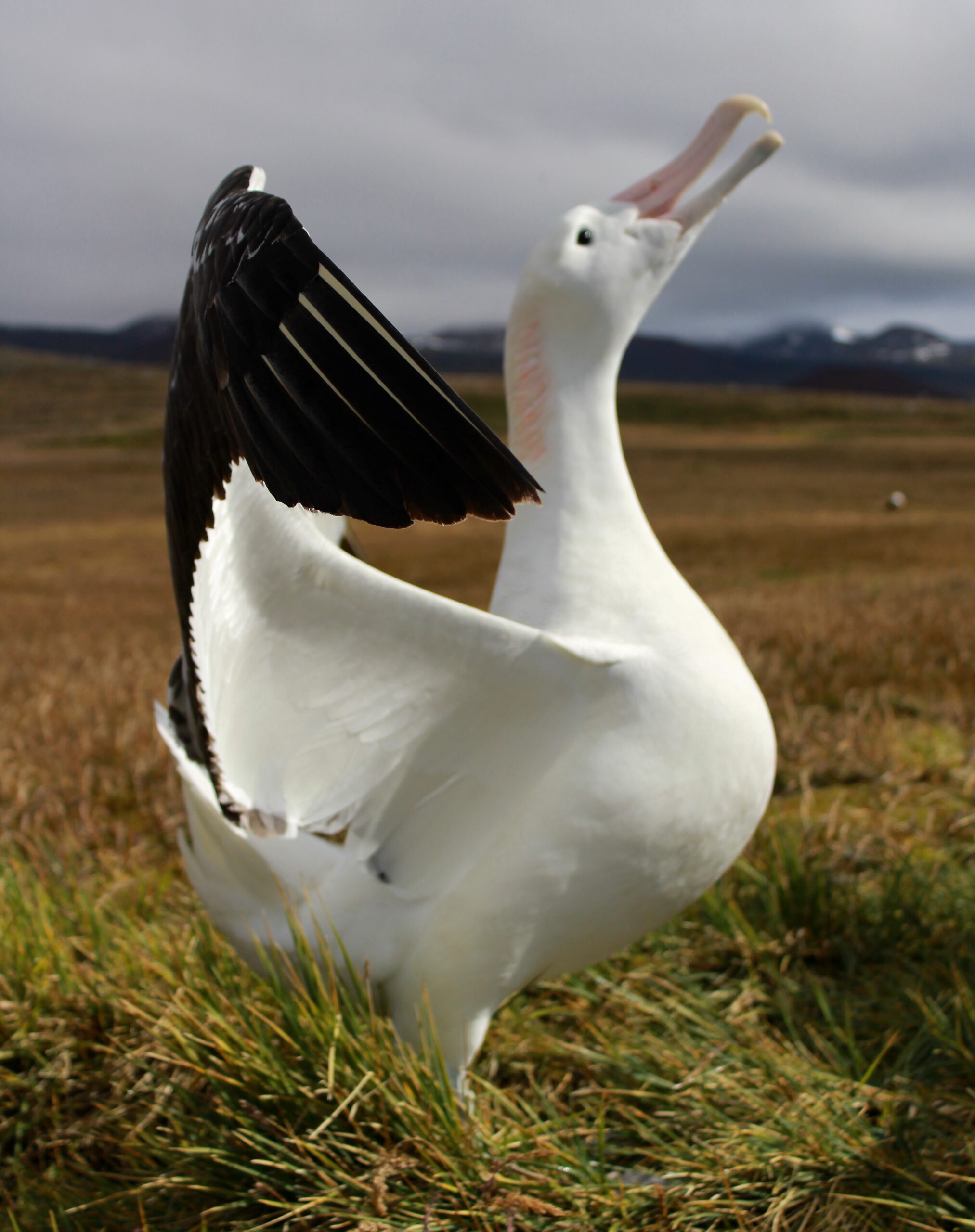
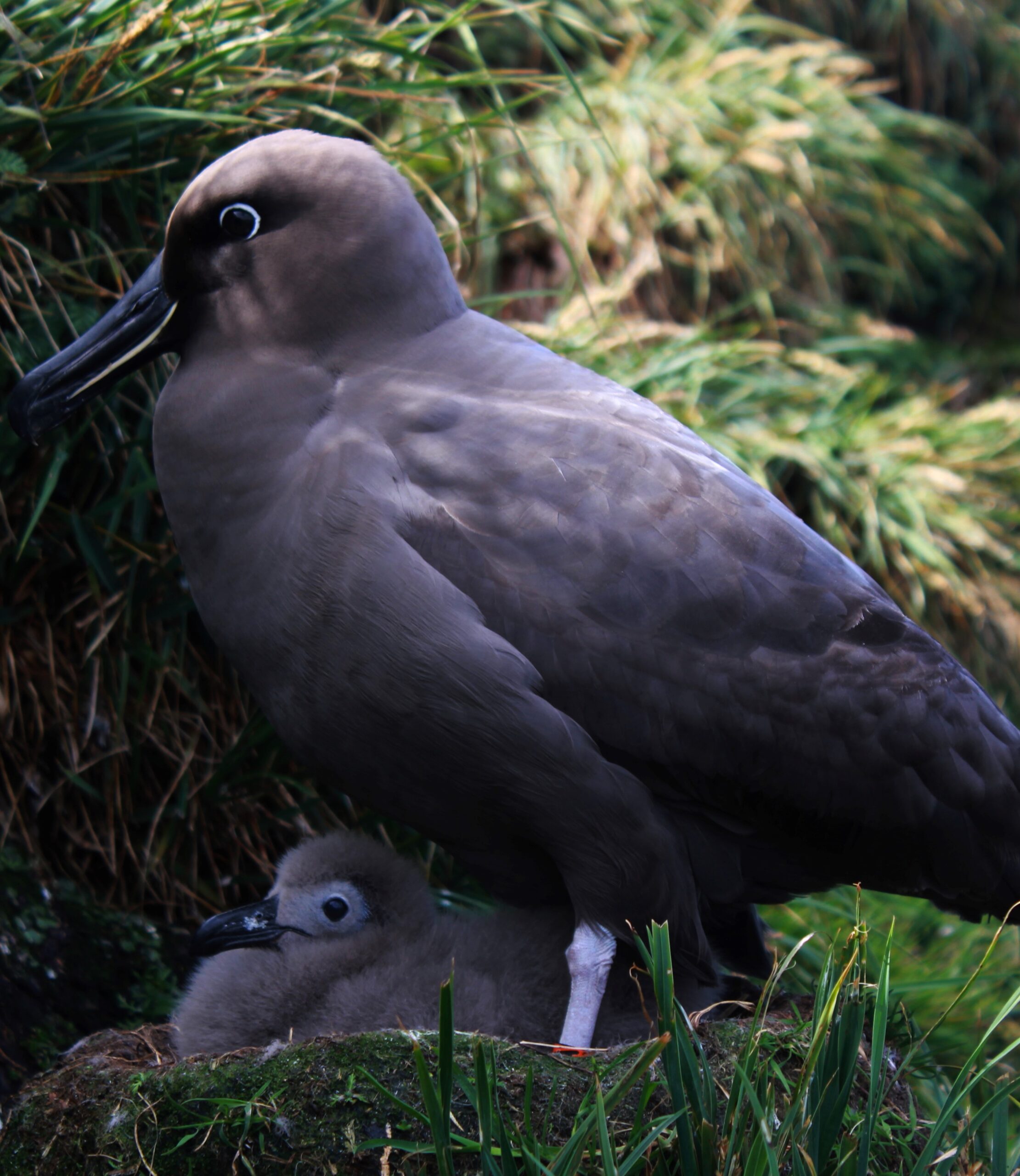
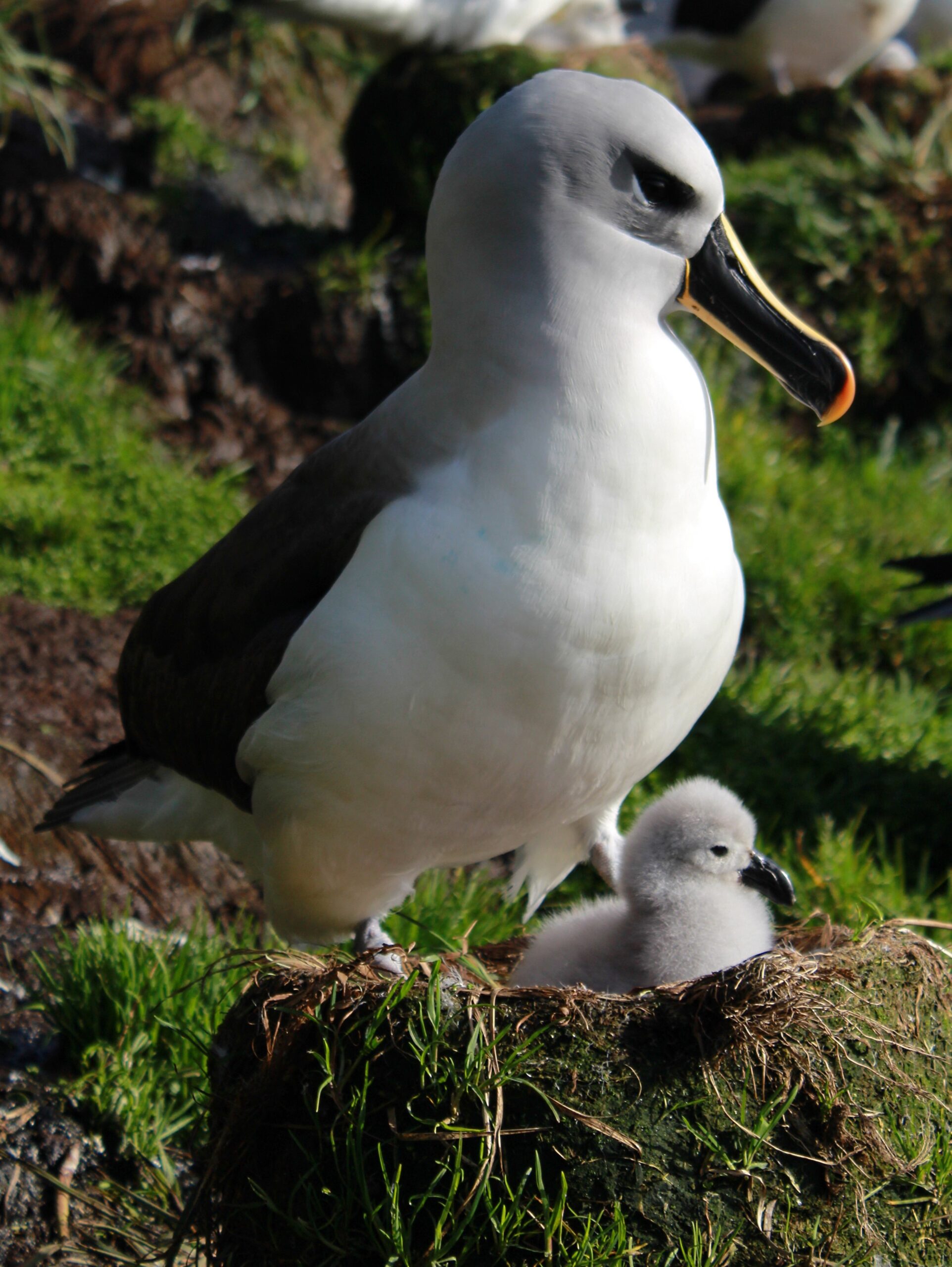
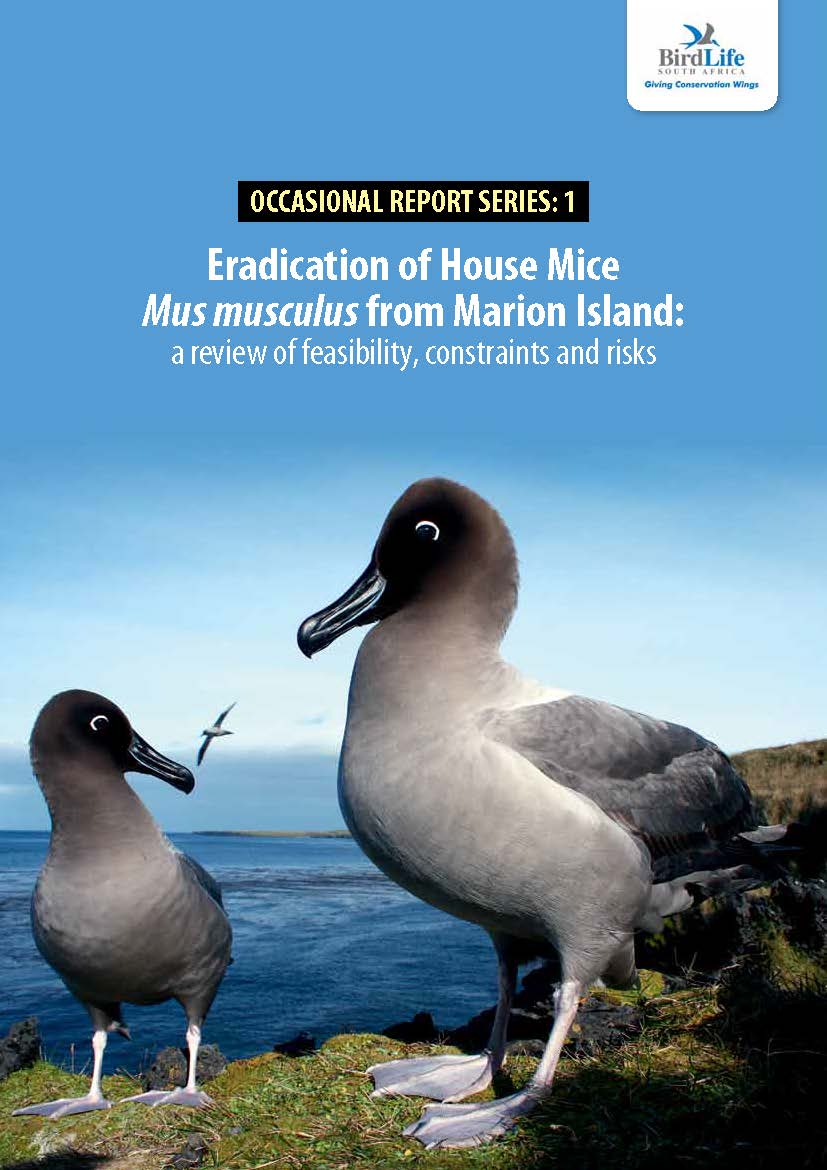 In what would later become a partnership with DFFE, a Feasibility Study and Risk Assessment, undertaken in 2016 by John Parkes on behalf of BirdLife South Africa (BLSA), indicated that eradication was indeed possible. Also funded by BLSA, Draft Project and Operational Plans to eradicate mice on Marion Island were subsequently developed in 2018 by New Zealand eradication expert, Keith Springer, following an island visit. DFFE has been working closely with the UK’s Royal Society for the Protection of Birds (RSPB) over the last few years in support of the Gough Island Restoration Programme (GIRP) which aims to eradicate House Mice on Gough during June to September 2021. For more information and the latest updates on the GIRP, please visit: https://www.goughisland.com
In what would later become a partnership with DFFE, a Feasibility Study and Risk Assessment, undertaken in 2016 by John Parkes on behalf of BirdLife South Africa (BLSA), indicated that eradication was indeed possible. Also funded by BLSA, Draft Project and Operational Plans to eradicate mice on Marion Island were subsequently developed in 2018 by New Zealand eradication expert, Keith Springer, following an island visit. DFFE has been working closely with the UK’s Royal Society for the Protection of Birds (RSPB) over the last few years in support of the Gough Island Restoration Programme (GIRP) which aims to eradicate House Mice on Gough during June to September 2021. For more information and the latest updates on the GIRP, please visit: https://www.goughisland.com
On 12 May 2020, a Memorandum of Understanding (MoU) for the Mouse-Free Marion (MFM) Project was signed between DFFE and BLSA. Subsequently, a MFM Management Committee was established to initiate the development of the project and the two MoU partners are now working closely, together with various experts and institutions (including those involved with successful operations on other islands), on the detailed planning on all operational aspects required for the execution of this complex and costly project.


The MFM Project will make use of internationally agreed best-practice approaches to eradicate mice from the island. The Feasibility Study and draft Project and Operational Plans highlight that the only methodology offering any chance of success on an island of the size and topography of Marion Island is aerial spreading of bait containing a rodenticide with a proven capacity to eradicate mice.  The systematic aerial sowing of bait will be conducted by GPS-guided helicopters with underslung bait buckets to ensure every single mouse territory is covered. The aerial baiting will be complemented by hand-baiting approaches in and around the base and other infrastructure on the island. If a single pregnant female is not targeted, it could result in the failure of the entire operation, but if it works, Marion Island will be by far the largest island in the world from which House Mice have successfully been eradicated.
The systematic aerial sowing of bait will be conducted by GPS-guided helicopters with underslung bait buckets to ensure every single mouse territory is covered. The aerial baiting will be complemented by hand-baiting approaches in and around the base and other infrastructure on the island. If a single pregnant female is not targeted, it could result in the failure of the entire operation, but if it works, Marion Island will be by far the largest island in the world from which House Mice have successfully been eradicated.
Time window trade-offs have been assessed and it has been determined that winter (April/May – August/September) is the optimal period in which to implement an eradication operation. This is the non-breeding period for mice at Marion, when their population size is low and natural food resources are minimal, rendering bait more attractive. A winter-baiting operation also reduces the risks to non-target seabird species on the island, as many are not resident on the island during the winter months.
Currently, the eradication exercise is planned for the austral winter of 2023 and, to review and update the Project and Operational Plans, a Project Manager (Dr Anton Wolfaardt – photo left) and an Operations Manager (Mr Keith Springer – photo right) have been appointed.
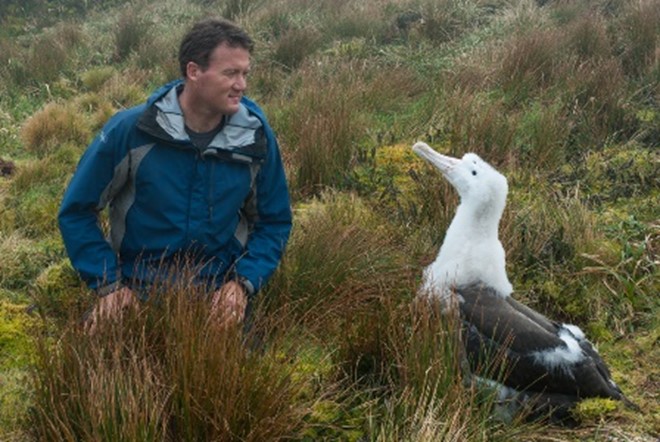
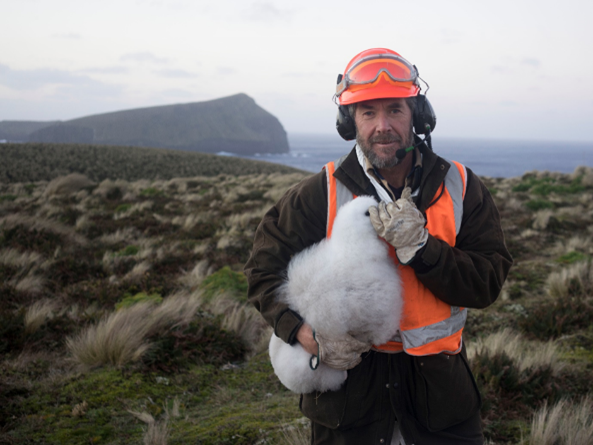
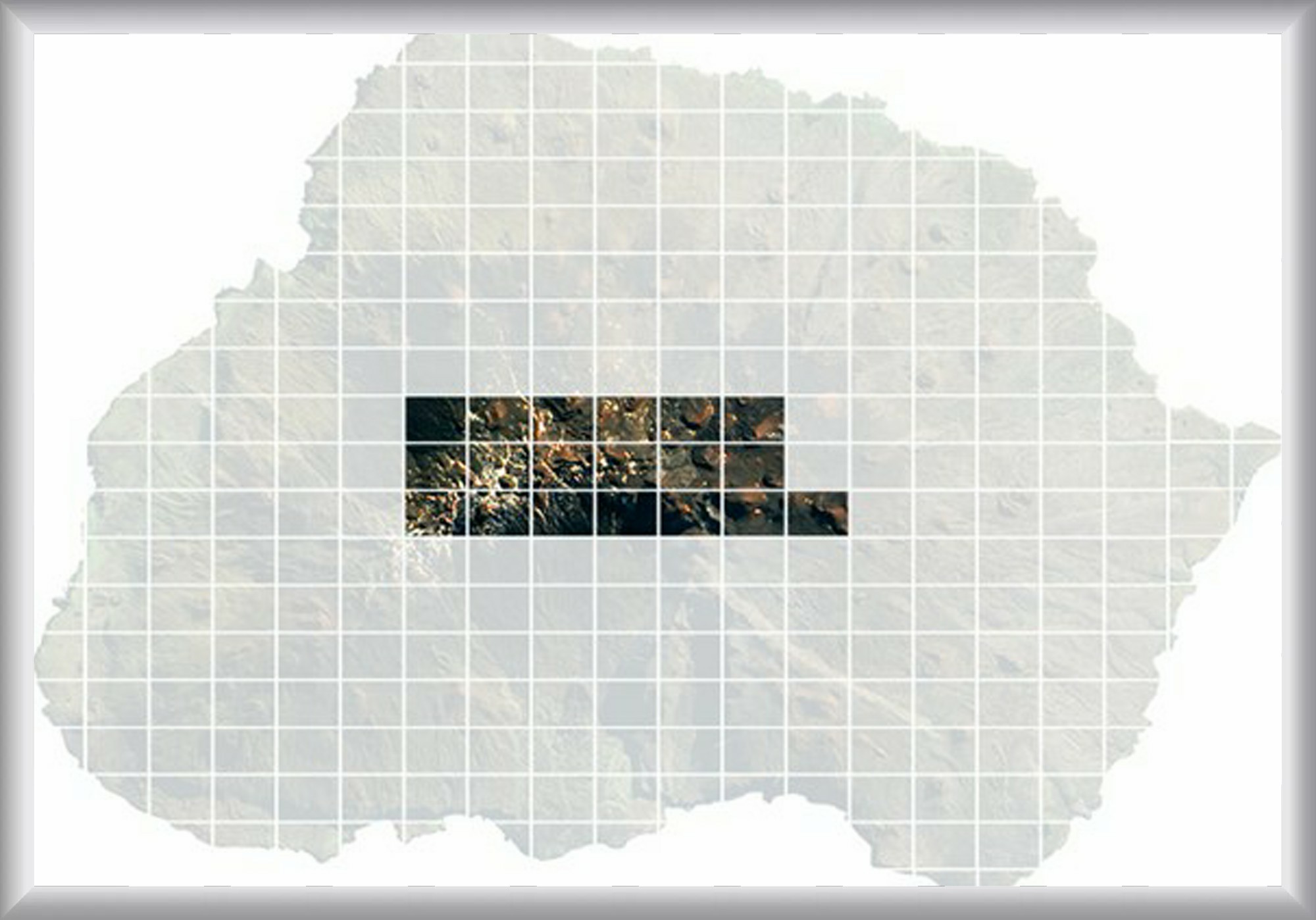 A project of this nature requires substantial funding. To date, funds provided and committed are comprised largely of donations, government funding and crowd sourcing to save Marion Island’s seabirds. For more information and the latest updates on the MFM Project, as well as to ‘Sponsor a Hectare’ (which is currently standing at just over R2 million), please visit http://www.mousefreemarion.org.za
A project of this nature requires substantial funding. To date, funds provided and committed are comprised largely of donations, government funding and crowd sourcing to save Marion Island’s seabirds. For more information and the latest updates on the MFM Project, as well as to ‘Sponsor a Hectare’ (which is currently standing at just over R2 million), please visit http://www.mousefreemarion.org.za
Text compiled by Carol Jacobs - Directorate: Biosecurity (DFFE)
Images from Marion Mouse Free Project, Stefan Schoombie,
FitzPatrick Institute and Antarctic Legacy of South Africa digital archive.
Cover Image: Otto Whitehead
,



 WANDERING ALBATROSS
WANDERING ALBATROSS SOOTY (OR DARK-MANTLED SOOTY) ALBATROSS
SOOTY (OR DARK-MANTLED SOOTY) ALBATROSS LIGHT-MANTLED (OR LIGHT-MANTLED SOOTY) ALBATROSS
LIGHT-MANTLED (OR LIGHT-MANTLED SOOTY) ALBATROSS GREY-HEADED ALBATROSS
GREY-HEADED ALBATROSS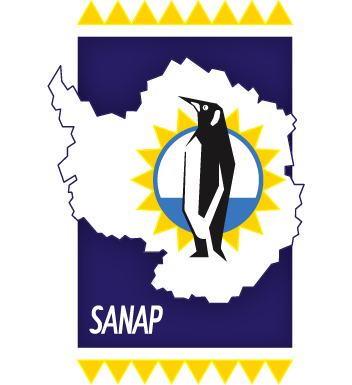









 This is particularly obvious in the Southern Ocean where a warmer and dryer environment allows the proliferation of species once limited by the cold climate. South African
This is particularly obvious in the Southern Ocean where a warmer and dryer environment allows the proliferation of species once limited by the cold climate. South African 
 For the next three years, the new SANAP project co-led by Dr Maëlle Connan (Research Fellow in the
For the next three years, the new SANAP project co-led by Dr Maëlle Connan (Research Fellow in the 
 (Above l-r: Sub-Antarctic Skua, Black-Faced Sheathbill)
(Above l-r: Sub-Antarctic Skua, Black-Faced Sheathbill)
 On one hand, Black-faced Sheathbills and Kelp Gulls used to predate on terrestrial invertebrates, at least seasonally, but this behaviour has decreased in sheathbills as invertebrate populations have collapsed through mouse predation. There are no recent data for Kelp Gulls. On the other hand, many pairs of Brown Skuas predate mainly on burrowing petrels, thus will inform on the recovery of these nocturnal species from mouse predation. The skua data will be complemented by the implementation of an automated acoustic monitoring to detect the presence and coarse distribution of the most elusive and cryptic nocturnal species which are notoriously difficult to study. (Left – Eleanor Weideman in the field on Marion Island.)
On one hand, Black-faced Sheathbills and Kelp Gulls used to predate on terrestrial invertebrates, at least seasonally, but this behaviour has decreased in sheathbills as invertebrate populations have collapsed through mouse predation. There are no recent data for Kelp Gulls. On the other hand, many pairs of Brown Skuas predate mainly on burrowing petrels, thus will inform on the recovery of these nocturnal species from mouse predation. The skua data will be complemented by the implementation of an automated acoustic monitoring to detect the presence and coarse distribution of the most elusive and cryptic nocturnal species which are notoriously difficult to study. (Left – Eleanor Weideman in the field on Marion Island.) Cover Image: Sub-Antarctic Skua – photo credit: Maelle Connan
Cover Image: Sub-Antarctic Skua – photo credit: Maelle Connan



 The House Mouse Mus musculus (Photo Credit: Stefan Schoombie), inadvertently introduced to Marion Island by sealers in the early 1800s, successfully established on the island. With the human occupation of the island in 1948, four cats were brought to the island to control the mice in and around the station. However, these cats bred on the island, with their offspring becoming feral, and by the 1970s the population had increased to about 2000 individuals that were killing some 450 000 birds per year, mostly chicks of burrow-nesting species.
The House Mouse Mus musculus (Photo Credit: Stefan Schoombie), inadvertently introduced to Marion Island by sealers in the early 1800s, successfully established on the island. With the human occupation of the island in 1948, four cats were brought to the island to control the mice in and around the station. However, these cats bred on the island, with their offspring becoming feral, and by the 1970s the population had increased to about 2000 individuals that were killing some 450 000 birds per year, mostly chicks of burrow-nesting species.  With South Africa’s successful eradication of the cats in 1991 (confirmed in 1992), until recently the largest island upon which this has been achieved, the mice continued to thrive and over the years have had devastating effects on Marion’s fragile ecosystem by negatively affecting invertebrate densities, impacting on the vegetation by consuming seed loads and preying upon the chicks of burrowing petrels (since the 1980s) and surface-breeding albatrosses (since 2003), with ‘scalpings’ occurring from 2009 and attacks on adult birds recorded more recently in 2019. (Image Credit: FitzPatrick Institute)
With South Africa’s successful eradication of the cats in 1991 (confirmed in 1992), until recently the largest island upon which this has been achieved, the mice continued to thrive and over the years have had devastating effects on Marion’s fragile ecosystem by negatively affecting invertebrate densities, impacting on the vegetation by consuming seed loads and preying upon the chicks of burrowing petrels (since the 1980s) and surface-breeding albatrosses (since 2003), with ‘scalpings’ occurring from 2009 and attacks on adult birds recorded more recently in 2019. (Image Credit: FitzPatrick Institute)


 In what would later become a partnership with DFFE, a
In what would later become a partnership with DFFE, a 

 The systematic aerial sowing of bait will be conducted by GPS-guided helicopters with underslung bait buckets to ensure every single mouse territory is covered. The aerial baiting will be complemented by hand-baiting approaches in and around the
The systematic aerial sowing of bait will be conducted by GPS-guided helicopters with underslung bait buckets to ensure every single mouse territory is covered. The aerial baiting will be complemented by hand-baiting approaches in and around the 

 A project of this nature requires substantial funding. To date, funds provided and committed are comprised largely of donations, government funding and crowd sourcing to save Marion Island’s seabirds. For more information and the latest updates on the MFM Project, as well as to ‘
A project of this nature requires substantial funding. To date, funds provided and committed are comprised largely of donations, government funding and crowd sourcing to save Marion Island’s seabirds. For more information and the latest updates on the MFM Project, as well as to ‘
